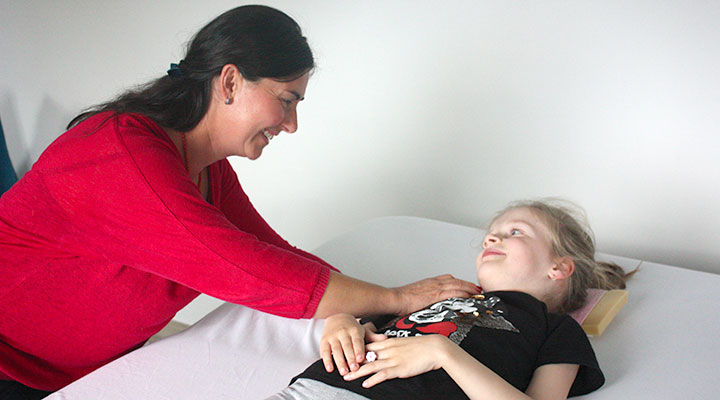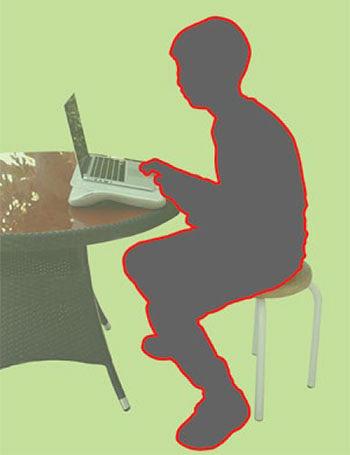For whom?
- Working with babies
- Working with children
- Rad s logopedom
- Working with adults
- Working in the sea
- Organisation of Alexander Technique courses
Working with children

Once upon a time, small children and children of all ages moved about much more than today.
Today’s children spend more time sitting while watching cartoons or playing games on their mobile phones, tablets, or TV sets. Sitting is not a problem in itself (if it does not last very long), but the problem is the way in which children sit. Already as infants, they do not develop sufficiently the freedom of hip motion which is very important for a good sitting position. When the hips are free, then it is possible to sit on your sit bones, which are designed for this, and the torso can then protrude upwards, whether you sit sideways, straight upwards or in a lotus position.
If the hips are not free, you do not sit on your sit bones, which are designed for sitting, and which are found in the lower part of the pelvis, but you sit on the sacral and lumbar (lower) part of the spine.
This teaches today’s children at the earliest age to acquire bad concepts of movement that later become a habit.
We must emphasise that it is not enough for a parent to tell a child who sits in a slouching position to straighten up for the child to acquire the right position. Neither is good, because in both cases rigidity and tension are maintained, and not the freedom of unimpeded breathing.
Another primary problem is the relationship between the head and the spine. If the head does not balance freely, it presses on the spine from above, which leads to a loss of ease and freedom of movement in all aspects of thinking, moving, feeling. Children today focus too much on what is happening on screens and can easily lose their free primary control (dynamic balance of the head in relation to the body).
Today’s children spend more time sitting while watching cartoons or playing games on their mobile phones, tablets, or TV sets. Sitting is not a problem in itself (if it does not last very long), but the problem is the way in which children sit. Already as infants, they do not develop sufficiently the freedom of hip motion which is very important for a good sitting position. When the hips are free, then it is possible to sit on your sit bones, which are designed for this, and the torso can then protrude upwards, whether you sit sideways, straight upwards or in a lotus position.
If the hips are not free, you do not sit on your sit bones, which are designed for sitting, and which are found in the lower part of the pelvis, but you sit on the sacral and lumbar (lower) part of the spine.
This teaches today’s children at the earliest age to acquire bad concepts of movement that later become a habit.
We must emphasise that it is not enough for a parent to tell a child who sits in a slouching position to straighten up for the child to acquire the right position. Neither is good, because in both cases rigidity and tension are maintained, and not the freedom of unimpeded breathing.
Another primary problem is the relationship between the head and the spine. If the head does not balance freely, it presses on the spine from above, which leads to a loss of ease and freedom of movement in all aspects of thinking, moving, feeling. Children today focus too much on what is happening on screens and can easily lose their free primary control (dynamic balance of the head in relation to the body).
In Alexander Technique classes, we teach children how to ease tension and get rid of bad concepts of thought, movement and feeling. We teach them how to establish a dynamic balance of the head in relation to the body, which is key for ease and freedom of movement. Children learn how to naturally and effortlessly stand up straight in all life situations. If they learn as children not to disrupt their primary control, their childhood will be more relaxed and easier, and new learning opportunities will open up for them.
Besides, problems that could appear in adulthood if inappropriate concepts of thought, movement and feeling are maintained will be prevented from the earliest age.
If children have failed to acquire good coordination due to illness, through the Alexander Technique we teach them about new possibilities of movement, which can be acquired thanks to the neuroplasticity of the brain, within the realistic potential of the child.
Besides, problems that could appear in adulthood if inappropriate concepts of thought, movement and feeling are maintained will be prevented from the earliest age.
If children have failed to acquire good coordination due to illness, through the Alexander Technique we teach them about new possibilities of movement, which can be acquired thanks to the neuroplasticity of the brain, within the realistic potential of the child.

